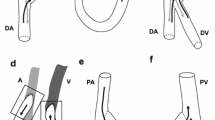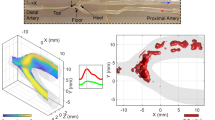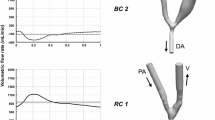Abstract
The creation of an arteriovenous fistula for hemodialysis has been reported to generate unstable to turbulent flow behaviour. On the other hand, the vast majority of computational fluid dynamic studies of an arteriovenous fistula use low spatial and temporal resolutions resolution in conjunction with laminar assumptions to investigate bulk flow and near wall parameters. The objective of the present study is to investigate if adequately resolved CFD can capture instabilities within an arteriovenous fistula. An experimental model of a representative fistula was created and the pressure distribution within the model was analysed for steady inlet conditions. Temporal CFD simulations with steady inflow conditions were computed for comparison. Following this verification a pulsatile simulation was employed to assess the role of pulsatility on bulk flow parameters. High frequency fluctuations beyond 100 Hz were found to occupy the venous segment of the arteriovenous fistula under pulsatile conditions and the flow within the venous segment exhibited unstable behaviour under both steady and pulsatile inlet conditions. The presence of high frequency fluctuations may be overlooked unless adequate spatial and temporal resolutions are employed. These fluctuations may impact endothelial cell function and contribute to the cascade of events leading to aggressive intimal hyperplasia and the loss of functionality of the vascular access.








Similar content being viewed by others
References
Asif, A., P. Roy-Chaudhury, and G. A. Beathard. Early arteriovenous fistula failure: a logical proposal for when and how to intervene. Clin. J. Am. Soc. Nephrol. 1:332–339, 2006.
Bharat, A., M. Jaenicke, and S. Shenoy. A novel technique of vascular anastomosis to prevent juxta-anastomotic stenosis following arteriovenous fistula creation. J. Vasc. Surg. 55:274–280, 2012.
Botti, L., K. Canneyt, R. Kaminsky, T. Claessens, R. N. Planken, P. Verdonck, A. Remuzzi, and L. Antiga. Numerical evaluation and experimental validation of pressure drops across a patient-specific model of vascular access for hemodialysis. Cardiovasc. Eng. Technol. 4:485–499, 2013.
Browne, L. D., P. Griffin, K. Bashar, S. R. Walsh, E. G. Kavanagh, and M. T. Walsh. In vivo validation of the in silico predicted pressure drop across an arteriovenous fistula. Ann. Biomed. Eng. 43:1275–1286, 2015.
Carroll, G. T., T. M. McGloughlin, P. E. Burke, M. Egan, F. Wallis, and M. T. Walsh. Wall shear stresses remain elevated in mature arteriovenous fistulas: a case study. J. Biomech. Eng. 133:021003, 2011.
Celik, I. B., U. Ghia, P. J. Roache, and C. J. Freitas. Procedure for estimation and reporting of uncertainty due to discretization in CFD applications., J. Fluids 130(7) 2008.
Cheng, N. S. Formula for the viscosity of a glycerol-water mixture. Ind. Eng. Chem. Res. 47:3285–3288, 2008. doi:10.1021/ie071349z.
Ene-Iordache, B., and A. Remuzzi. Disturbed flow in radial-cephalic arteriovenous fistulae for haemodialysis: low and oscillating shear stress locates the sites of stenosis. Nephrol. Dial. Transplant. 27:358–368, 2012.
Fillinger, M. F., E. R. Reinitz, R. A. Schwartz, D. E. Resetarits, A. M. Paskanik, D. Bruch, and C. E. Bredenberg. Graft geometry and venous intimal-medial hyperplasia in arteriovenous loop grafts. J. Vasc. Surg. 11:556–566, 1990.
Lee, S., P. Fischer, F. Loth, T. Royston, J. Grogan, and H. Bassiouny. Flow-induced vein-wall vibration in an arteriovenous graft. J. Fluids Struct. 20:837–852, 2005.
Lee, S.-W., D. S. Smith, F. Loth, P. F. Fischer, and H. S. Bassiouny. Importance of flow division on transition to turbulence within an arteriovenous graft. J. Biomech. 40:981–992, 2007.
Loth, F., P. F. Fischer, N. Arslan, C. D. Bertram, S. E. Lee, T. J. Royston, W. E. Shaalan, and H. S. Bassiouny. Transitional flow at the venous anastomosis of an arteriovenous graft: potential activation of the ERK1/2 mechanotransduction pathway. J. Biomech. Eng. 125:49–61, 2003.
McGah, P. M., D. F. Leotta, K. W. Beach, J. J. Riley, and A. Aliseda. A longitudinal study of remodeling in a revised peripheral artery bypass graft using 3D ultrasound imaging and computational hemodynamics. J. Biomech. Eng. 133:041008, 2011.
Pustjens, L. W. J. Three-dimensional modeling to derive the pressure drop-flow relation at an AertioVenous Fistula. M.S. Thesis, Eindhoven University of Technology, 2013.
Rajabi-Jagahrgh, E., M. K. Krishnamoorthy, Y. Wang, A. Choe, P. Roy-Chaudhury, and R. K. Banerjee. Influence of temporal variation in wall shear stress on intima-media thickening in arteriovenous fistulae. Semin. Dial. 26:511–519, 2013.
Sigovan, M., V. Rayz, W. Gasper, H. F. Alley, C. D. Owens, and D. Saloner. Vascular remodeling in autogenous arterio-venous fistulas by MRI and CFD. Ann. Biomed. Eng. 41:657–668, 2013.
Sivanesan, S. Flow patterns in the radiocephalic arteriovenous fistula: an in vitro study. J. Biomech. 32:915–925, 1999.
Van Canneyt, K., T. Pourchez, S. Eloot, C. Guillame, A. Bonnet, P. Segers, and P. Verdonck. Hemodynamic impact of anastomosis size and angle in side-to-end arteriovenous fistulae: a computer analysis. J. Vasc. Access 11:52–58, 2010.
Conflict of Interest
All authors declare that they have no conflict of interest.
Statement on Human and Animal Studies
No human studies were carried out by the authors for this article. No animal studies were carried out by the authors for this article.
Author information
Authors and Affiliations
Corresponding author
Additional information
Associate Editor Ajit P. Yoganathan oversaw the review of this article.
Electronic supplementary material
Below is the link to the electronic supplementary material.
Rights and permissions
About this article
Cite this article
Browne, L.D., Walsh, M.T. & Griffin, P. Experimental and Numerical Analysis of the Bulk Flow Parameters Within an Arteriovenous Fistula. Cardiovasc Eng Tech 6, 450–462 (2015). https://doi.org/10.1007/s13239-015-0246-6
Received:
Accepted:
Published:
Issue Date:
DOI: https://doi.org/10.1007/s13239-015-0246-6




